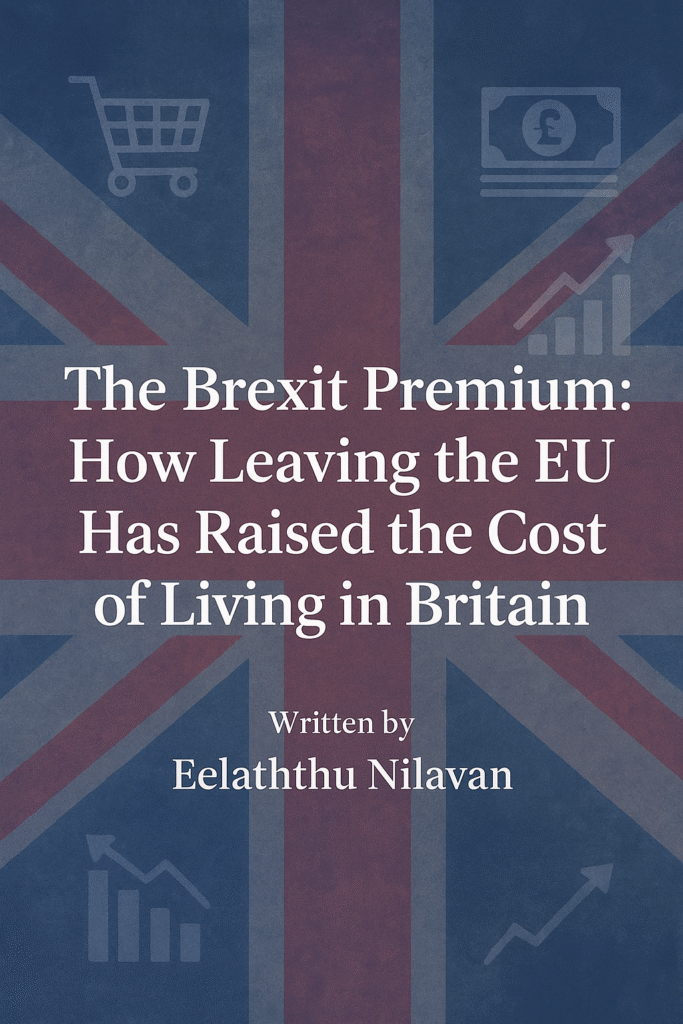✧. Abstract
This paper examines the economic costs, often unstated or underappreciated, that Brexit has imposed on UK households since 2016. These include weakened sterling, trade frictions (tariffs, non-tariff barriers, customs delay), regulatory divergence, labour shortages, and resultant inefficiencies. Drawing on updated data through 2024–2025, we quantify many of these effects, assess their persistence, and examine distributional impacts (across income deciles, regions, and sectors). We also evaluate policy options for reducing the ongoing “premium”. The conclusion is that many of the Brexit-related costs are baked in and permanent unless major policy changes occur; these costs have materially worsened inflation, reduced growth, widened inequality, and imposed thousands of extra pounds per household per year.

✧. Table of Contents
Introduction
✪.Mechanisms of the Brexit Premium
Sterling depreciation and import costs
Border frictions and non-tariff barriers
Regulatory divergence and compliance costs
Labour market adjustments and shortages
Trade and export declines
✪.Quantifying the Costs: Evidence to 2025
Inflation, food prices, and consumer goods
Energy, fuel, services
Trade flows, firm-level evidence
Real wages, household income, and regional effects
✪Permanence: Why Many Costs Are Structural
Exogenous shocks vs. policy-driven shifts
Regulatory divergence and long supply chains
Migration policy and labour supply
Investment, productivity, and growth potential
✪Who Pays the Price
Lower-income vs higher-income households
SMEs vs large firms
Regions (Northern vs Southern England; devolved nations)
Sectors: agriculture, food, manufacturing, services
✪.Policy Responses and Possible Mitigations
Trade agreement improvements/alignment
Reducing non-tariff barriers, simplifying customs / SPS checks
Labour migration reform, skills policies
Fiscal policy: social support, tax relief, regulation
Currency / monetary policy influences
✪.Conclusion
✦. Introduction
Since the referendum decision in 2016, the UK has undergone a series of legal, economic, political, and institutional changes with the EU. While many costs of Brexit were anticipated (or warned about), some have turned out to be higher, more persistent, or more diffuse than predicted. As inflation surged globally (due to COVID-19 disruptions, supply chain shocks, the Russian invasion of Ukraine, energy costs) many UK citizens found that Brexit exacerbated those pressures.
This paper defines the “Brexit premium” as the cumulative additional costs borne by households (via higher prices, reduced choice, wage impacts, lost growth) that stem, directly or indirectly, from Brexit‐related changes. It explores what those are, how large, who bears them, and whether they will fade or persist.
✦. Mechanisms of the Brexit Premium
Here we describe the channels by which Brexit adds to costs.
2.1 Sterling Depreciation and Import Costs
After the referendum, sterling fell significantly (≈10-20%) relative to major currencies. A weaker currency raises the cost of imported goods and inputs. Even non-imported goods that use imported components are affected.
Ongoing currency weakness has had “pass-through” effects on consumer prices.
2.2 Border Frictions and Non-Tariff Barriers
Even though the Trade and Cooperation Agreement (TCA) allows zero tariffs on many goods traded between the UK and EU, it requires strict rules of origin, customs declarations, additional paperwork, sanitary and phytosanitary (SPS) checks, veterinary checks etc.
Delays at borders, additional transportation costs, holding costs, inspection costs raise costs for firms, which are (at least partially) passed on to consumers.
2.3 Regulatory Divergence and Compliance Costs
The UK has diverged from EU regulation in areas like chemicals, agriculture, food safety, veterinary standards. This forces exporters (and importers) to comply with both UK and EU rules.
New licensing requirements for exporting agricultural/food products to the EU are a clear recent cost: in 2024 UK firms spent up to £65 million on obtaining export licences for food/agricultural products to the EU.
2.4 Labour Market Adjustments and Shortages
Ending free movement has reduced ease of migration from the EU, particularly low-skilled and seasonal workers. Sectors like agriculture, food processing, transport, hospitality have reported labour shortages attributable to Brexit.
These shortages increase wage pressures, raise recruitment/training costs, lower productivity.
2.5 Trade and Export Declines
UK goods exports to the EU remain below their pre-Brexit / pre-pandemic levels: in 2024, goods exports to the EU were about 18% below their 2019 level in real terms. Non-EU exports were also ~14% below 2019.
Many small firms have been disproportionately affected by the increased fixed cost of exporting, compliance and paperwork.
✦. Quantifying the Costs: Evidence to 2025
Here, I summarise what the data (academic, government, think tanks) show up to mid-2025 for the magnitude of the Brexit premium.
3.1 Inflation, Food Prices, Consumer Goods
Research from LSE’s Centre for Economic Performance (CEP) shows that by end-2021, Brexit had increased food prices by about 6% compared to what they would have been otherwise. Households paid an extra ≈£210 on food over two years (2020-21).
For poorer households, the effect is larger in relative terms: the same research found for the lowest income deciles the overall cost of living increase attributable to Brexit was ≈ 1.1%, versus ≈ 0.7% for the top deciles.
3.2 Energy, Fuel, Services
While many of the rises in energy/fuel/wider services costs post-2020 arose from global shocks (energy markets, war in Ukraine), Brexit exacerbated them by increasing import costs of fuel, complicating investments, limiting labour supply for services supporting those sectors, and reducing competition.
3.3 Trade Flows, Firm-level Evidence
From 2019 to 2024, goods exports to both EU and non-EU countries have remained below pre-pandemic/Brexit levels: ~18% down to EU, ~14% down non-EU in real terms (goods exports).
Small and medium-sized enterprises (SMEs) have been hardest hit by fixed costs of customs, licensing, export procedures. Many have dropped exporting to the EU entirely. CEP estimates a 6.4% fall in UK global exports and a 3.1% decline in imports from rest of world connected with these frictions.
3.4 Real Wages, Household Income, Regional Effects
Because inflation has been high, and because cost increases from Brexit add to inflationary pressure, real wage growth has lagged. Some studies suggest that UK GDP is several percentage points below where it would have been without Brexit, which means lower incomes for households in aggregate.
Regional variation: regions more dependent on trade with the EU, agriculture, sectors heavily reliant on EU labour (e.g. Northern Ireland border regions, rural England, agriculture) have had more acute impacts. Urban, diversified areas suffer less. London, for example, has had its growth dampened but still retains many advantages; its report shows post-Brexit investment and productivity have been slowed.
3.5 Ballpark Estimates per Household
Putting all this together, the “hidden tax” per household depends on income, composition, location, consumption basket, but plausible estimates are:
For a typical UK household (middle income, not especially rural, mixed consumption basket): £300-£700/year extra in food, goods, compliance costs etc., from border frictions, import cost increases etc., above what would likely have been without Brexit (excluding general inflation).
Including broader effects (lower wage growth, slower GDP growth, lost export opportunities, labour shortages) the cost could be £1,000-£2,000/year in opportunity cost (less income, less growth, fewer public services etc.) for many households, particularly lower-income or exporting regions.
These are rough estimates by aggregating studies; some households pay much more (especially those with large food or imported goods consumption, or in sectors hit by labour shortages) and some less.
✦. Permanence: Why Many Costs Are Structural
Which of the Brexit premium costs will fade, and which are likely permanent?
4.1 Exogenous vs Policy-Driven Shifts
Some costs stem from one-off or transitional changes (initial supply chain disruption, initial regulatory misalignment). Others stem from policy choices (migration rules, trade policy, divergence in regulation) that have not been reversed.
Without policy intervention, many components (regulatory divergence, reported customs/trade costs) will remain.
4.2 Regulatory Divergence and Long Supply Chains
Businesses that have adapted to dual regimes (UK + EU compliance) incur recurring costs.
Over time, firms restructure supply chains, but often at cost: switching inputs, relocating facilities, paying tariffs/inspections etc.
4.3 Migration Policy and Labour Supply
The UK’s post-Brexit immigration system limits free movement; quotas, visas, points-based rules. Many sectors have persistent shortages. Unless immigration policy changes or domestic skills policies fully compensate, labour cost pressure remains.
With demographic trends, ageing, etc., labour scarcity may worsen, especially regionally.
4.4 Investment, Productivity and Growth Potential
Trade openness is a key driver of productivity. With reduced trade intensity, fewer foreign direct investment (FDI) and less integration in EU value chains, productivity growth is slower. That reduces potential GDP permanently.
Export declines, especially in goods, reduce scale for UK firms; firms miss out on economies of scale.
Thus much of the Brexit premium is not a temporary spike but baked into the system unless key policies reverse or mitigate the costs.
✦. Who Pays the Price
The burden is not equally distributed.
5.1 Income Distribution
Lower-income households spend a greater share of their income on food, energy, basic imports; thus higher percentage cost increases hurt them more. Studies (e.g. LSE/CEP) found poor households see ≈1.1% uplift in cost of living from Brexit food price effects vs ≈0.7% for richer households.
Also, lower income workers may have less bargaining power over wages, less ability to substitute consumption, or relocate.
5.2 Firms: SMEs vs Large
SMEs have less capacity to absorb fixed compliance costs and regulatory burdens. Paperwork, licensing, customs procedures are more expensive per unit for small exporters.
Larger firms may pass costs on, exploit scale to negotiate, or re-structure supply chains to reduce exposure.
5.3 Regional Effects
Regions heavily dependent on trade with the EU or on EU labour: e.g. East Anglia, agriculture regions, rural Scotland, Northern Ireland.
Urban centres with diversified economy fare relatively better; London suffers from investment drag but has other buffers.
5.4 Sectors
Agriculture, food processing, fisheries: labour shortages, SPS checks, export licensing costs.
Manufacturing with complex input-output supply chains: delays and extra paperwork increase costs; loss of competitiveness.
Consumer goods that are imported or rely on imported parts.
Services: some loss of mobility for labour & professional qualifications; increased non-tariff barriers hamper services exports to EU.
✦. Policy Responses and Possible Mitigations
What can be done to reduce or spread the premium, or offset its effects?
6.1 Trade Agreement Improvements / Alignment
Negotiating further alignment or mutual recognition of standards, reducing SPS / veterinary checks, simplifying rules of origin.
UK-EU agreements to reduce or eliminate the licensing costs for food exports (which currently cost firms ~£65m/year).
6.2 Reducing Non-Tariff Barriers, Simplifying Customs
Improve, streamline customs procedures; better digitalisation; reduce delays.
Investing in border infrastructure and customs capacity to avoid bottlenecks.
6.3 Labour Migration Reform, Skills Policies
Adjust migration policy to allow low-skilled/seasonal workers more easily in sectors with shortages.
Expand apprenticeships, domestic training in skills that replace roles formerly filled by EU workers.
6.4 Fiscal Policy: Social Support, Regulation
Targeted tax relief or subsidy in sectors most impacted (food, energy, agriculture).
Strengthening safety nets for low-income households facing high inflation.
6.5 Monetary / Exchange Rate Considerations
While the Bank of England does not control sterling entirely, ensuring stable macroeconomic policy helps avoid further currency devaluation which feeds into import costs.
✦. Conclusion
Brexit has introduced a complex, multi-dimensional premium on living costs in Britain. Some costs were expected; others have been larger or more persistent than early forecasts. Many of the components (regulatory divergence, trade frictions, labour shortages, loss of export scale, weakened sterling) are structural and unlikely to disappear without sustained policy reform both domestically and in relations with the EU. The burden falls hardest on lower income households, SMEs, trade-dependent regions, and certain sectors (food, agriculture, manufacturing).
Although global shocks (pandemic, war, energy crisis) have played major roles in recent inflation, Brexit has acted to magnify those shocks and to reduce buffers (whether labour, trade or regulatory) that might otherwise help. For households, the extra cost is not trivial: from hundreds to over a thousand pounds per year, depending on circumstances.
If the UK wishes to reduce the Brexit premium, it must prioritize trade facilitation, regulatory alignment (or equivalence), smarter migration policy, improvement of customs infrastructure, and better support for vulnerable households. Even then, some legacy costs are permanently embedded.
References (selected)

︎ London School of Economics, Centre for Economic Performance. Research on non-tariff barriers and consumer prices: Evidence from Brexit.

︎ House of Commons Library: Statistics on UK-EU trade (2024).

︎ CER (Centre for European Reform). “A perfect storm: Britain’s trade malaise, weak growth …” (2025)

︎ GLA Economics. “The impact of Brexit on London’s Economy – 2023 Report.”

︎ Studies on labour markets and trade impacts by ECB, think tanks etc.
Author’s Note
This paper is written by Eelaththu Nilavan, drawing on public economic research, government and academic data as of mid-2025. Any errors or omissions are my responsibility; the interpretations reflect the best judgments derived from available sources.
Author Tagline
Eelaththu Nilavan is an independent economist and researcher, specialising in trade policy, labour markets and public welfare.

Author:

Eelaththu Nilavan


